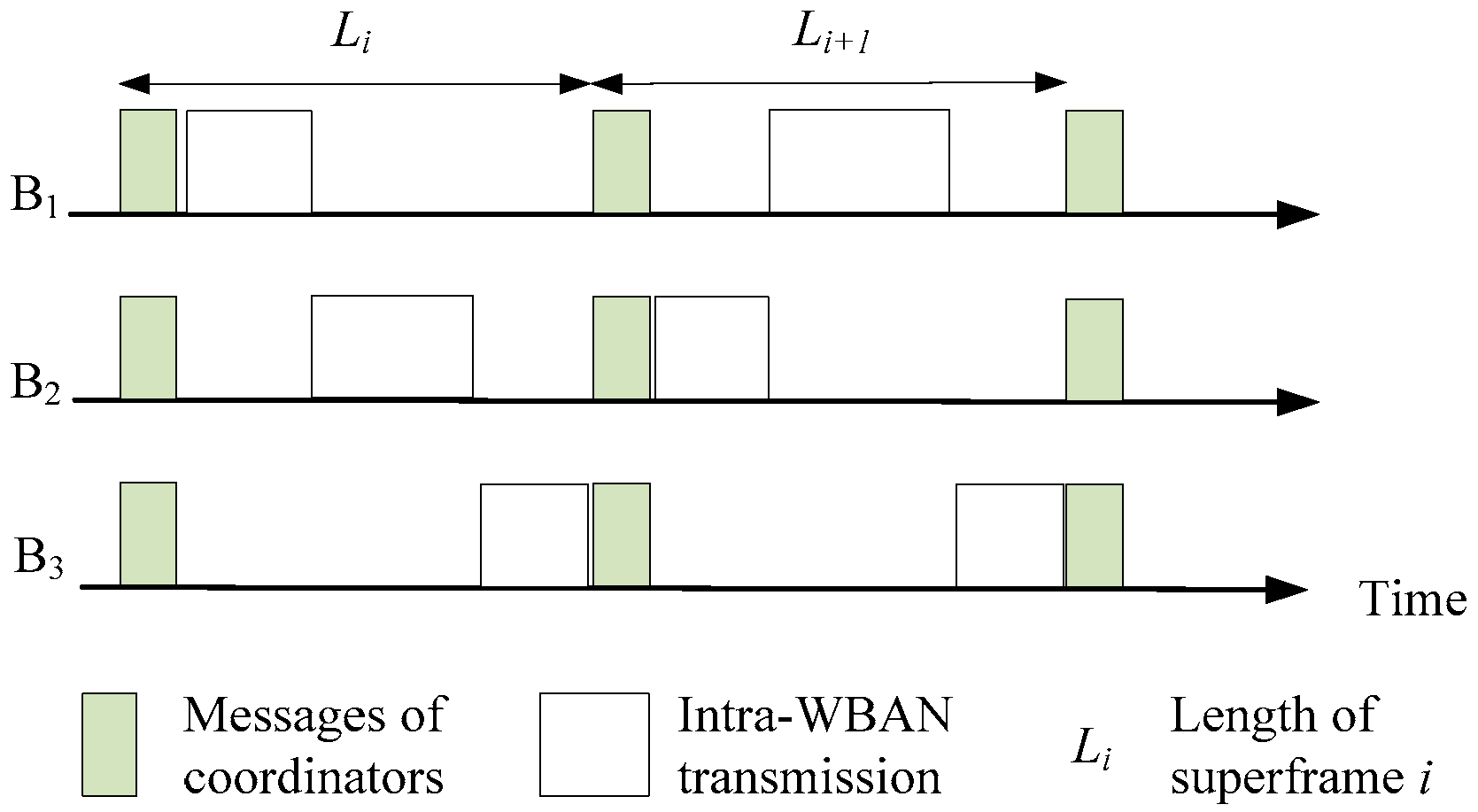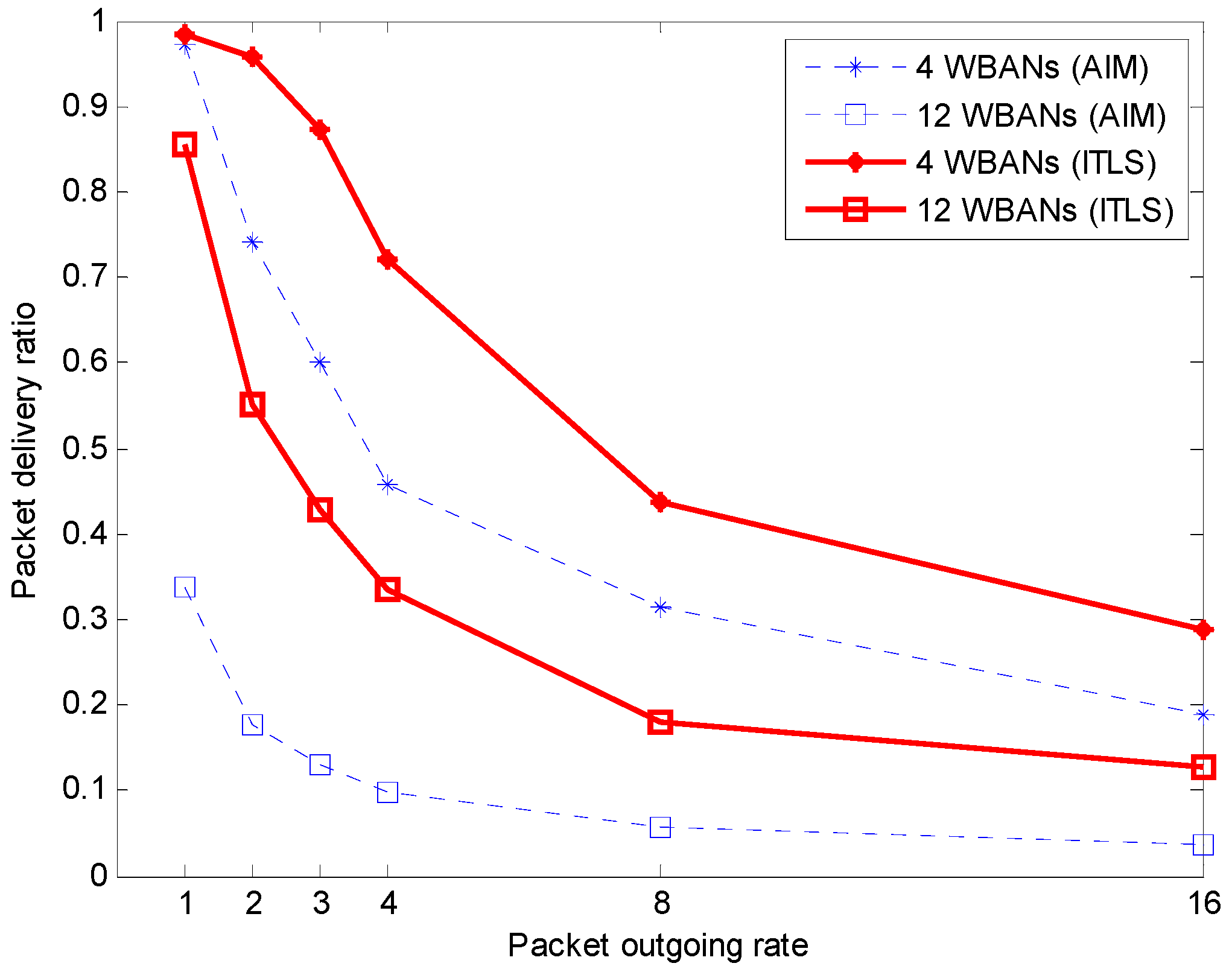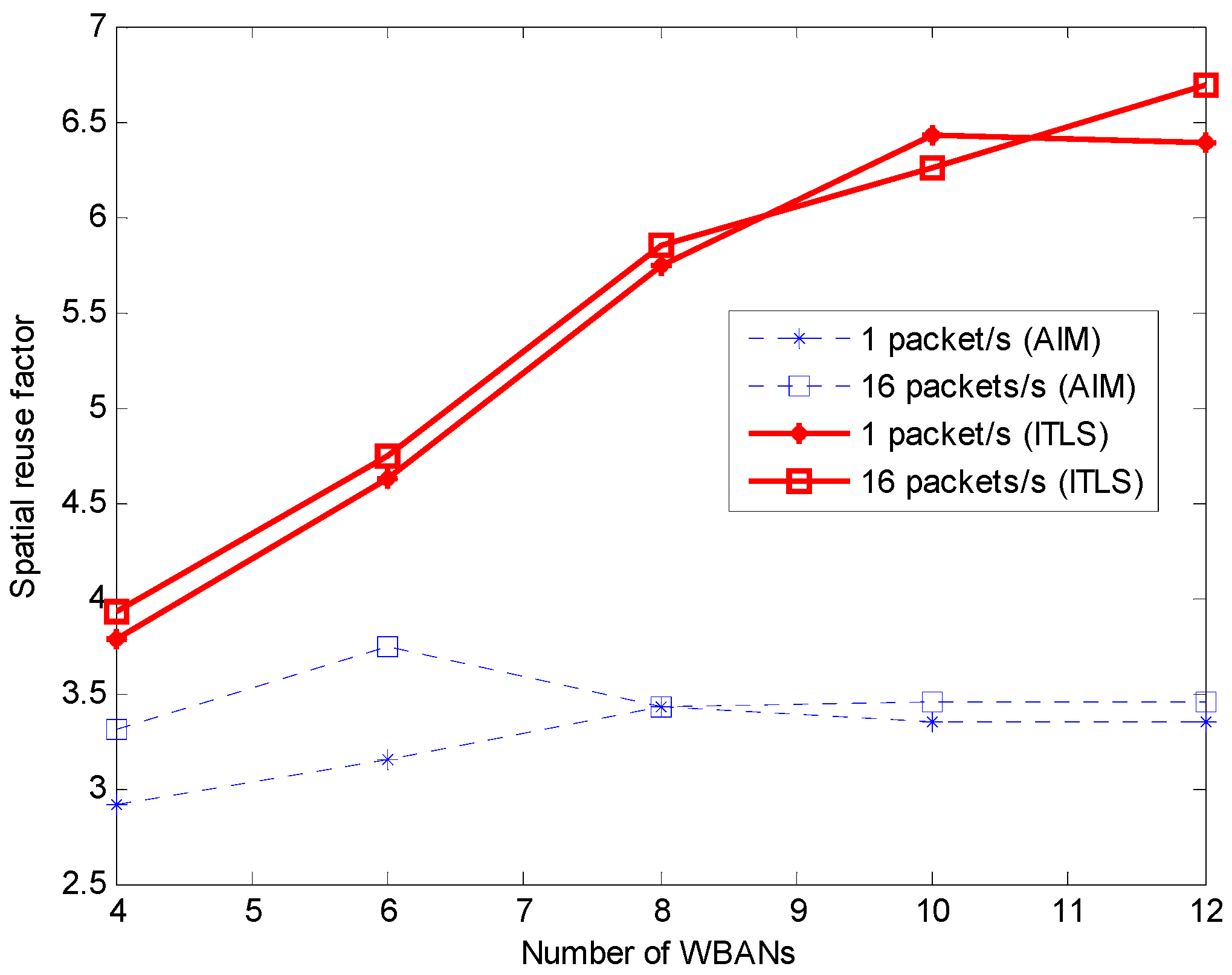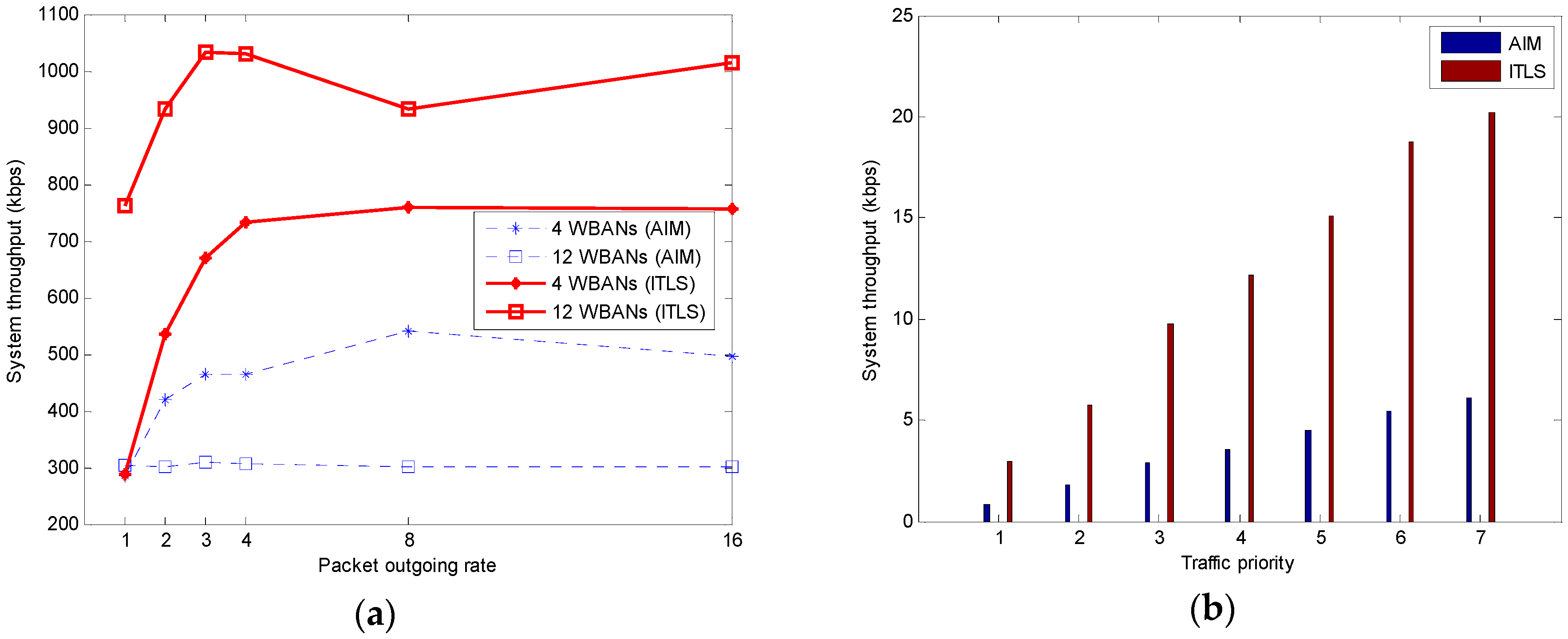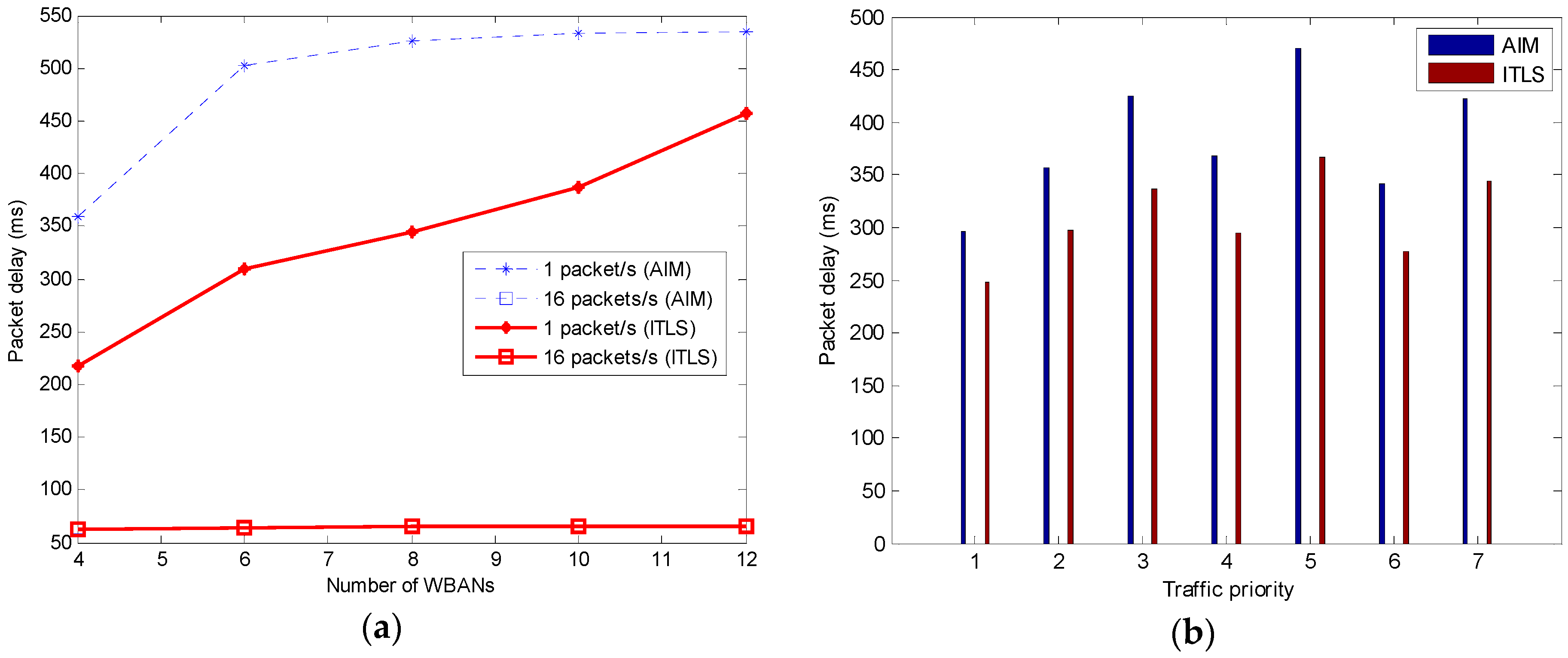In this section, we present our proposed link scheduling algorithm for a network of n WBANs. The network model is introduced first, and the problem of link scheduling in multiple WBANs is formulated. Then, the proposed algorithm is presented in detail with examples, and it is compared to conventional algorithms qualitatively.
3.1. Network Model and Interference Graph Generation
In multiple WBANs, interference can occur if more than two neighboring nodes transmit at the same timeslot and a receiver exists in the overlapped area of their transmission ranges. That is, an interfered node is the node existing within the overlapped area of the transmission ranges.
In our algorithm, the transmission of all WBANs is successfully scheduled into the superframe, where the superframe length is divided into T timeslots. We also assume that a WBAN is formed as a simple star topology consisting of a coordinator and a group of wireless sensor nodes, and the WBAN topology does not change during one superframe.
We consider a network with
n WBANs labeled
B1,
B2, …,
Bn that exist within the interference range of each other. The communication coverage of each WBAN is modeled as a circle of radius
r, where the coordinator is placed at the center and
m sensor nodes are placed within the circle. The sensor nodes carry the vital signals of the human body, which are classified into eight different categories as per the IEEE 802.15.6 standard [
2], as listed in
Table 2. Each WBAN can be described by a list of sensors with traffic priority. The
j-th sensor in
Bi is represented as s
i,j, and the traffic priority of the
j-th sensor in
Bi is denoted as
pi,j, where 1 ≤
j ≤
m. Assume that for each type of traffic priority, the length of the generated packets is different; therefore, the transmission time of sensor node s
i,j at priority
pi,j is represented as
ti,j =
u(
pi,j)/
b(
pi,j), where
u(
pi,j) is the packet length and
b(
pi,j) is the data rate of priority
pi,j. For each WBAN, the coordinator schedules the transmission of the sensor nodes using the TDMA scheme. The sensor nodes receive a beacon message from the coordinator, and then transmit the vital signals following the TDMA schedule.
As given in reference [
30], we assume that body-to-body links are modeled by free space path loss model without shadowing, with the path loss exponent of 2. This path loss is exponentially increased with the increased distance between WBANs. The channel gain of body-to-body links is modeled as gamma distribution as in reference [
31].
At every WBAN, the coordinator discovers its neighbors using distance-based interference: if the distance between two coordinators is less than the transmission range, two WBANs interfere with each other. The list of WBANs interfering with Bi is represented by Li = {j|di,j < r}, where di,j is the distance between Bi and Bj and r is the transmission range. Given n WBANs, the interference graph is represented by graph G = (V, E); V(G) is the set of WBANs, i.e., V(G) = {B1, B2, …, Bn}, and E(G) is the set of interfered links between WBANs, i.e., E(G) = {(i, j)|i∈Lj, j∈Li}. In case there is no interference between WBANs, E(G) = φ.
At WBAN
Bi, the coordinator creates interfered sensor group
ISGi that consists of all the sensor nodes interfered by the neighbors. The coordinator always monitors the SINR of its sensor nodes,
γi,j, and compares the SINR with the threshold SINR,
γth. In the IEEE 802.15.6 standard, the transmitted power is set as −20 dBm and the sensitivity of receiver is set at −90 dBm in the noisy environment. Because we use the free space path loss model for body-to-body links, we have evaluated the SINR of an intra-WBAN communication while increasing the number of nearby WBANs from 1 to 12. As a result, the SINR value is below 0 dBm. Therefore, in this paper, we assume that the threshold SINR is 0 dBm. If SINR at a sensor is below the predetermined threshold, the sensor can be considered as an interfered sensor. SINR at sensor
si,j in
Bi,
γi,j, can be represented as:
where
Pi,j is the received signal power at
si,j (originates from the coordinator of
Bi),
Pl,j is the interference power that originates from
Bl (from the coordinator or any sensor) and received by the sensor
si,j, and σ
2 is the power of additive noise. If
γi,j <
γth, sensor
si,j is listed in the interfered sensor list
ISGi from the coordinator. That is,
ISGi = {
si,j|
γi,j <
γth}, where 1 ≤
j ≤
m. Otherwise, sensor
si,j is added to the non-interfered sensor list
NISGi from the coordinator. All WBANs create the interfered sensor list and exchange it with their neighbors at every superframe.
While considering traffic priority, we calculate the weighted interference of each sensor,
wi,j, as follows:
The weighted interference is used not only for calculating the interference level of each coordinator but also for obtaining the contention value (which will be presented in
Section 3.3) in defining the weight constraint of each WBAN at each timeslot. Each coordinator calculates its interference level by adding the weighted interference of the sensors in
ISGi, as follows:
The parameters and notations are listed in
Table 3.
3.2. Problem Formulation
In a network with
n WBANs, each of which consists of
m sensor nodes, we assume that there are
m ×
n orthogonal transmissions in one superframe that contains
T timeslots. The maximum number of required timeslots is
T =
m ×
n. The number of received packets of
si,j at the coordinator of
Bi is
ui,j. The total network throughput is calculated as:
In order to increase the network throughput, we aim to maximize the number of nodes that can transmit at the same timeslot. This leads to a problem of maximizing the shared timeslots among WBANs. The number of transmissions in
n WBANs is
m ×
n, and |
T| is the set of timeslots in one superframe. At the
k-th timeslot of the superframe, there are up to
n transmissions in
n WBANs that go from the sensor nodes to their coordinators; the scheduling decision can be represented by a vector
zk = [
zi,j,k,
zl,h,k, …,
zm,n,k], where
zi,j,k = 1 if the
j-th sensor in
Bi is scheduled in the
k-th timeslot; otherwise,
zi,j,k = 0. Two WBANs can share the same timeslot if they do not share the same edge (i.e., the same interference link) in the interference graph. Because of the difference in traffic priority levels, the required transmission time of each priority can be different from the others. Given the traffic priority level of each sensor node, we assume that the WBAN with high priority can occupy the channel until its transmission finishes. In order to find the maximum number of WBANs that can transmit in one timeslot, we formulate the scheduling problem as an optimization problem:
In this formulation, the scheduling algorithm attempts to maximize the number of sensors that can transmit in the
k-th timeslot. However, the network throughput is measured in data packets per second, and the objective Equation (5) is rewritten as follows:
subject to:
We present a traffic-priority-based scheduling algorithm for Equation (6). Because the scheduling problem has a slotted structure in the time domain, multiple transmissions from multiple WBANs can be scheduled in one timeslot. There are some constraints in Equation (6) as follows: if more than two WBANs interfere with each other, only one sensor node that belongs to the ISGs of two neighbors can transmit at the k-th timeslot; this constraint is shown in Equation (6a). The non-interfered WBANs can share the same timeslot, as indicated in Equation (6b). In order to avoid intra-WBAN interference, the constraint in Equation (6c) shows that only one sensor node of a WBAN can transmit at one timeslot. The j-th sensor node of the i-th WBAN is active at the k-th timeslot if zi,j,k = 1; otherwise, zi,j,k = 0, as indicated in Equation (6d). In Equation (6e), the length of the k-th timeslot is the longest transmission time of all the sensor nodes that are active in the k-th timeslot.
3.3. ITLS Algorithm
The step-by-step operation of the proposed ITLS algorithm is given in Algorithm 1. This algorithm executes at the coordinator of each WBAN and solves the problem in Equation (6). We use a contention value (CV) to define the weight constraint of each WBAN at each timeslot, as follows:
where
Ii,k is the list of interfered sensors in the
i-th WBAN at the
k-th timeslot. The contention value of
Bi is denoted as
CV(
i,
k) which is used to content the timeslot indexed by
k in the superframe. The coordinator of
Bi calculates its contention value which is defined by the summation of the weighted interference values of the sensors in the
ISGi as shown in Equation (7).
Each WBAN is assigned to the scheduling vector of each superframe; the scheduling vector consists of the timeslot index for each sensor node in the superframe. In Algorithm 1, at each timeslot, all WBANs calculate their contention value, as shown in line 3. If other WBANs interfere with a given WBAN, the latter exchanges its scheduling message with its neighbors before starting transmission. The superframe structure is shown in
Figure 2, where the coordinators of WBANs will exchange the message with their neighbors before starting intra-WBAN communication. The interfered WBAN compares its contention value with that of the interfering WBANs (line 4). The winner in this step is the WBAN with the highest CV. The active sensor with the highest priority is chosen for scheduling (lines 5 to 7). In lines 8 to 11, the winner’s neighbors choose the sensor node to transmit at the
k-th timeslot. In lines 12 to 15, the non-neighbors of the winner choose the sensor node to transmit at the
k-th timeslot.
| Algorithm 1: ITLS algorithm |
| Input: G = (V, E), T |
| Output: zi,j,k, tk, and K |
| Each WBAN creates its Li, ISGi, and NISGi; |
| Initialize a temporal vector for Bi: a temporal scheduling value for each j-th sensor in each Bi: zi,j,1 = 0; list of interfered sensor at first slot: Ii,1 = ISGi, list of non-interfered sensor at first slot: NIi,1 = NISGi |
while all WBANs are not scheduled if k < T calculate contention value CV(i,k)|∀i∈V as in (7) find CVmax = max(CV(i,k); return j-th sensor of i-th WBAN (j∈Ii,k) find required transmission time for si,j, which is ti,j,k set zi,j,k = 1; remove j of Ii,k update tk = ti,j,k to network for each Bl∈Li return h-th sensor of l-th WBAN (h∈NIl,k) such that h-the sensor has the highest priority set zl,h,k= 1; remove h of Il,k end for for each Bx∉Li return y-th sensor of x-th WBAN (y∈Ix,k) such that y-th sensor has the highest priority set zx,y,k = 1; remove y of Ix,k end for update k = k + 1 end if end while update K = k
|
In one timeslot, the high priority sensor node can occupy the channel, and more than one WBAN can transmit via the channel with low interference, thus ensuring the continuity of transmission. When the coordinator records any changes to the SINR of its sensor node, the coordinator updates scheduling for the new transmission at the end of the existing superframe. Otherwise, the scheduling is kept the same.
3.4. ITLS Example
An ITLS example is shown in
Figure 3. Assume that there are three WBANs, B
1, B
2, and B
3 that work at the same time and at the same place. Three WBANs and their interference areas are shown in
Figure 3a. The sensor list of each WBAN with traffic priority written in parenthesis is as follows: B
1 = {11(1), 12(4), 13(5)}, B
2 = {21(2), 22(1), 23(2)}, and B
3 = {31(1), 32(2), 33(3)}. The interference areas of the WBANs consist of the sensor nodes {13, 21, 22, 31} as shown in
Figure 3a. Each WBAN creates its
ISG and
NISG as listed in
Table 4.
At the first timeslot,
B1 has the highest CV (because of the priority of the interfered sensors) and
ISG(1) = {13}; therefore,
B1 occupies the channel and sensor “13” is the highest priority sensor node in
ISG(1) that transmits data; while
NISG(3) is {32, 33},
B3 can choose one of the sensors in its
NISG to transmit. The scheduling decision at the first timeslot is
B1(13) and
B3(33). At the second timeslot,
B2 has the highest CV; therefore, one of the sensor nodes in
ISG(2) can transmit data; because
B3 does not share the same edge,
B3 can transmit. The scheduling decision at the second timeslot is
B2(21) and
B3(32). The final scheduling among WBANs is shown in
Figure 3b. The total required timeslot for three WBANs is nine orthogonal transmissions, but the proposed algorithm requires five timeslots. Therefore, the spatial reuse is 9/5, and up to two sensor nodes can share the same timeslot.
3.5. Qualitative Comparison of Link Scheduling Algorithms
In this subsection, a qualitative comparison of link scheduling algorithms for multiple WBANs is summarized and discussed. The comparison results are summarized in
Table 5.
The interference model of multiple WBANs is based on SINR or distance. A WBAN can be interfered if the transmission ranges of WBANs are overlapped and the SINR of sensor nodes is below the threshold. For example, the coordinator can detect the interfered sensor node based on SINR in DRA and AIM. Moreover, if the distance between two coordinators is less than the mutual interference range between WBANs, those WBANs are interfered as in the RIC and CBWS algorithms. In our proposed algorithm, the coordinator detects the interfered sensor nodes using the SINR model. The scheduling decision is made at the coordinator that can consider the entire WBAN or individual sensor nodes. Among the existing link scheduling algorithms, RIC schedules WBANs, whereas DRA, AIM, and CBWS schedule the sensor nodes. Scheduling all the sensor nodes in multiple WBANs is advantageous in comparison to the two-step hierarchical approach of scheduling among WBANs first and scheduling among sensor nodes within a WBAN. As a consequence, nodes can avoid collision with the transmission of other WBANs. Our proposed ITLS schedules the sensor nodes with regard to interference level and traffic priority. Among the existing link scheduling algorithms, only AIM schedules the sensor nodes based on traffic priority, whereas the others do not consider traffic priority. The existing algorithms are based on TDMA, where each sensor node is assigned to the fixed timeslot. In our proposed algorithm, the set of transmission links from the sensor nodes to the coordinator is mapped into one timeslot.

